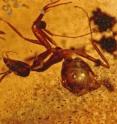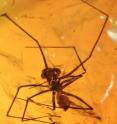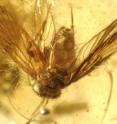New trove of fossils suggests global distribution of tropical forest ecosystems in the Eocene
Bees, termites, spiders, and flies entombed in a newly-excavated amber deposit are challenging the assumption that India was an isolated island-continent in the Early Eocene, or 52-50 million years ago. Arthropods found in the Cambay deposit from western India are not unique—as would be expected on an island—but rather have close evolutionary relationships with fossils from other continents. The amber is also the oldest evidence of a tropical broadleaf rainforest in Asia. The discovery is published this week in Proceedings of the National Academy of Sciences. "We know India was isolated, but when and for precisely how long is unclear," says David Grimaldi, curator in the Division of Invertebrate Zoology at the American Museum of Natural History. "The biological evidence in the amber deposit shows that there was some biotic connection."
"The amber shows, similar to an old photo, what life looked like in India just before the collision with the Asian continent," says Jes Rust, professor of Invertebrate Paleontology at the Universität Bonn in Germany. "The insects trapped in the fossil resin cast a new light on the history of the sub-continent."
Amber from broadleaf trees is rare in the fossil record until the Tertiary, or after the dinosaurs went extinct. It was during this era that flowering plants rather than conifers began to dominate forests and developed the ecosystem that still straddles the equator today. The new amber, and amber from Colombia that is 10 million years older, indicates that tropical forests are older than previously thought.
In the research paper, Grimaldi, Rust, and colleagues describe the Cambay amber as the oldest evidence of tropical forests in Asia. The amber has been chemically linked to Dipterocarpaceae, a family of hardwood trees that currently makes up 80 percent of the forest canopy in Southeast Asia. Fossilized wood from this family was found as well, making this deposit the earliest record of these plants in India and showing that this family is nearly twice as old as was commonly believed. It most likely originated when portions of the southern supercontinent Gondwana were still connected.
Also reported in the paper are 100 arthropod species that represent 55 families and 14 orders. Some of these species are early relatives of highly social, or eusocial, insects like honey bees and stingless bees, rhinotermitid termites, and ants, suggesting that these groups radiated during or just prior to the early Eocene. And many of the Cambay fossils have relatives on other continents—although not where it would be expected. Rather than finding evolutionary ties to Africa and Madagascar, landmasses that India had most recently been linked to as part of Gondwana, the researchers found relatives in Northern Europe, Asia, Australia, and the Americas.
"What we found indicates that India was not completely isolated, even though the Cambay deposit dates from a time that precedes the slamming of India into Asia," says Michael Engel, a professor in the Department of Ecology and Evolutionary Biology and curator of entomology at the University of Kansas. "There might have been some linkages."
Climate might have also played a role in the fauna found in the Cambay amber. The Early Eocene was a time of great climatic warmth: the tropics reached the poles. The researchers predict that the climate would have had an effect on the distribution of arthropods.
"The Cambay Formation spans a period of great warmth which led to a profusion of tropical groups spread around the world," says Grimaldi. "The diversity and evolutionary relationships in the Cambay deposit show how profound an effect climate has on groups."
Source: American Museum of Natural History
Articles on the same topic
- Huge amber deposit discovered in IndiaMon, 25 Oct 2010, 19:51:59 UTC
Other sources
- 50 Million Year-Old Amber Trove Foundfrom CBSNews - ScienceThu, 28 Oct 2010, 2:30:37 UTC
- 50 Million Year-Old Amber Trove Foundfrom CBSNews - ScienceThu, 28 Oct 2010, 2:00:46 UTC
- 50 Million Year-Old Amber Trove Foundfrom CBSNews - ScienceTue, 26 Oct 2010, 12:50:50 UTC
- 50 Million Year-Old Amber Trove Foundfrom CBSNews - ScienceTue, 26 Oct 2010, 9:20:18 UTC
- Fossils in amber give clue to India's pastfrom UPITue, 26 Oct 2010, 0:00:32 UTC
- Observatory: Encased in Amber, a Trove of New Speciesfrom NY Times ScienceMon, 25 Oct 2010, 21:30:09 UTC
- Amber yields ancient bug haulfrom BBC News: Science & NatureMon, 25 Oct 2010, 20:10:24 UTC
- Prehistoric creatures discovered in huge Indian amber haulfrom The Guardian - ScienceMon, 25 Oct 2010, 19:50:35 UTC
- Huge amber deposit discovered in Indiafrom PhysorgMon, 25 Oct 2010, 19:50:29 UTC
- Insects in ancient amber reveal surprising tiesfrom MSNBC: ScienceMon, 25 Oct 2010, 19:40:10 UTC
- Insects in Ancient Amber Reveal Unexpected India-Asia Tiesfrom Live ScienceMon, 25 Oct 2010, 19:30:39 UTC
- In pictures: Insects in amber shed light on India's pastfrom The Guardian - ScienceMon, 25 Oct 2010, 19:20:27 UTC


